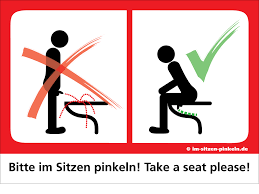(Warning: some disgust in what follows.)
Everybody will have noticed when they are invited for dinner, there are two kinds of households. The ones in which men sit when they urinate, and those in which they don’t. A quick olfactive check is more than enough to get the facts. Sitters and standers, as we call them, are our characters here. In an ideal world, all men are sitters.
This will create nicer restroom atmospheres, will simplify public architectures (in some cases it is difficult to pack two restrooms, one for each gender), will solve the problem of less populated genders (where does a transgender person go to?), will make the job of the cleaning person easier and less humiliating (and who is the cleaning person? often a woman, in the family or in the public space) and sitters are apparently healthier in the long run: you name you preferred advantage.
As the world is less than ideal, the next design problem is to turn standers into sitters. All of them, or a significant portion of them. In a totalitarian world, you may decree that standers are somewhat banned and punished, or sitters rewarded. In our world, you can try to nudge standers. Here are some ideas, none of which is, admittedly, very convincing.
1. Signage? Directive pictograms?

2.
Well, for one thing, these may be interpreted as somewhat descriptive: there are two categories, standers and sitters, and maybe one restroom is designated for standers? Moreover, the directive power of directions is not automatic: it depends on the existence of a set of shared values, which apparently is the source of the problem, as standers do not share those values.
3.
CC cameras in bathrooms? Not even worth a mention so we do not even mention them here.
4.
Dedicated sensors in bathrooms? Not as controversial as cameras, but still too much close to data collection in a space that is paradigmatically private.
5.
Restroom with windows at head height? Hmm, interesting. If you stand, we can see you head, so we can see you are not sitting. But stigma solutions are very hard to accept, and raise ethical issues.
6.
Robust information campaigns? But standers are, in the end, rational agents: they thrive in a world of sitters, as they can have their cake and eat it too: clean restrooms, without the pain of breaking a well established, traditional habit. And it is worth repeating that campaigns are not as effective as measures (see also Distraction can kill). As a matter of fact, this highlight one of the problems of the Nudge solution: short of convincing the quasi-totality of the population, the result will always be fragile. A few standers will spoil any restroom in no time, thus convincing sitters that their own effort is not worth.